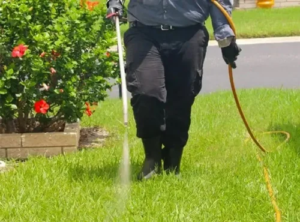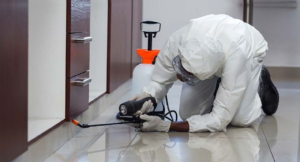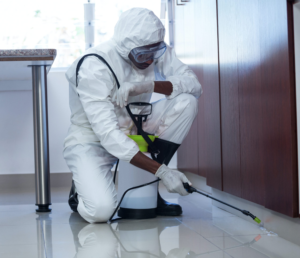Few homes and buildings are free of pests, from rodents like rats and mice to insects such as ants and mosquitoes. These pests can cause damage and pose health risks.
Keeping the house clean can help deter many pests, as can regularly removing food and water sources and reducing shelter sites. Other management methods include traps, baits and sprays. Contact Pest Control Nampa now!

The goal of pest control is to prevent or minimize the occurrence of pests. Prevention strategies can include physical, biological and chemical methods. These approaches should be used in an integrated fashion and should always keep in mind the impact of any action on the environment.
Scouting — the process of regularly searching for and identifying pests — is an important component of preventative pest management. It helps to understand pest life cycles, as well as their damage potential. It’s also helpful to know how often a particular species can be expected to occur, as this can help establish thresholds for intervention. For example, a few bees in the yard once or twice a year probably doesn’t require treatment, but if you start seeing them every day and in increasing numbers, it may be time to take action.
A variety of factors influence the growth and activity of pest populations, including climate, natural enemies, natural barriers, available food and water sources, and shelter. Some pests also tend to be more active in certain seasons, making them easier or harder to detect and control.
There are many ways to deter pests, such as eliminating food and water sources, denying them shelter, and blocking their entry into buildings. Some techniques are easy enough for individuals to do, such as keeping trash receptacles closed and cleaning them frequently and washing out empty food containers. Others are more difficult, such as installing screens on windows and patching holes in walls.
Pests can cause damage to structures, plants and personal property, and they can also pose health risks to people and animals. Some have a foul odor or taste, while others can bite or sting, like flies, wasps and cluster flies. Still others stain or damage fabrics, such as boxelder bugs and pine seed bugs, and some can carry diseases, such as rats, cockroaches, fleas and bedbugs.
Some pests, such as pigeons and starlings, are migratory and recur regularly, while others, such as termites, are continuous pests that need regular control. Most pests, however, can be categorized as either sporadic or continuous.
Suppression
Pests such as rodents, cockroaches, termites, and bed bugs can cause serious health problems. They can also damage property. Having a pest control service protects people and their businesses from these unwanted creatures. The service also aids in locating the root of the problem to prevent future infestation. The services offered by a pest control company protect a variety of industries, including healthcare, agriculture, and food production.
Identifying the pests is the first step in developing a pest control strategy. This is critical because the type of pest determines what control tactics are used. The pest identification process is done by trapping, scouting, and monitoring. Threshold-based decision making relates to determining when the pest numbers reach a point that warrants action. For example, if a few wasps are observed in a restaurant patio, that doesn’t warrant action, but if a dozen or more wereps are found in the same spot every day, then a plan is in place to remove their nest.
Physical controls such as barriers, nets, traps, and thorns can help keep the number of pests down. Altering the environment by altering temperature, moisture levels, or light can also help to control certain pests.
Chemical control consists of poisons, hormones, and other substances that destroy or alter pests. Pesticides are often the most effective way to control pests, but they can have adverse effects on living organisms and nonliving materials at the treatment site. They can also be dangerous to people if not applied properly.
Biological control relies on a pest’s natural enemies to reduce its population, such as parasites, predators, and pathogens. Sometimes these natural enemies are enhanced to increase their ability to suppress the pest population, for example by releasing more predators or adding more pathogens. In other cases, the use of pheromones or juvenile hormones is used to disrupt the pest’s life cycle and lower its numbers.
Biological pest control goes even further by using bacteria, viruses, and fungi to kill the unwanted organisms. Microscopic nematodes, such as the roach-eating Steinernema carpocapsae, are sprayed onto soil to help control fleas, grubs, and worms by injecting them into insect larvae so they die.
Eradication
Pests can spread diseases, contaminate food and damage property. A professional pest control company will use a range of methods to eradicate pests, including baiting and trapping as well as chemical spraying. In general, biological control is less likely to have side effects on the environment than chemical treatments. The word “eradicate” comes from the Latin verb eradicare, meaning “to uproot.” It originally meant literally to pull something up by its roots, and this is still a good metaphor for what pest control professionals do when they eliminate infestations of insects, rodents, plants or any other unwanted organism.
Pest infestations can cause serious health problems, such as cockroaches that carry bacteria and trigger asthma attacks in some people. They can also destroy property, such as rats that chew through drywall and wire to create nests. Regular inspections by a pest control expert can identify signs of infestation and help prevent a problem before it occurs.
Physical pest control involves removing or blocking the entry points of the pests, such as putting up traps for mice or flies or blocking holes with copper mesh and expanding foam. It can also involve methods such as soil cultivation to kill weeds or spraying weed killer on fields.
Some physical pest control methods can be as simple as placing a bowl of vinegar near the sink to attract fruit flies, or sprinkling cinnamon powder in areas where ants and cockroaches enter. Other solutions include using pheromones, which can confuse male insects or prevent them from mating, thus lowering the population; introducing predatory organisms such as ladybugs to kill pests; and applying juvenile hormones, which stop females from maturing into reproductive adults.
The most effective way to control pests is through prevention, but this is not always possible. Often, the best approach is to hire a professional pest control service to prevent infestations in the first place. Regular inspections will help businesses to identify conducive conditions and deal with them before pests take hold, reducing costs associated with cleanup and repairs. In addition, trained pest control experts will know how to spot the early warning signs of a problem, such as droppings and gnaw marks.
Biological Control
Biological control is the use of living organisms (predators, parasites, pathogens) to reduce pest populations to economically acceptable levels. The goal is to achieve long-term suppression of the pest with minimal or no intervention from human beings. This approach is more sustainable than conventional pesticides and can be integrated into an integrated pest management program.
Agricultural producers and gardeners can use many types of biological control in their production systems. Generally, these biological agents (such as lady beetles, lacewings, hover fly larvae, or entomopathogenic nematodes) are already present in the cropping system but need to be supplemented in order to control the target pest. Biological control is highly specific and can significantly reduce or replace the need for chemical pesticides.
There are two main methods of using biological control: classical and augmentation. Classical biocontrol involves importing and releasing natural enemies that are specifically suited to the problem at hand. This method requires extensive testing to ensure that the organisms attack only the desired pest and do not cause damage or harm to other species. The pest is identified and a natural enemy is collected from the same general location, passed through rigorous quarantine, reared to population sizes that are sufficient for release, and then released at the site of pest infestation.
Most growers, gardeners and professionals employ augmentative biocontrol to supplement the action of existing predators, parasites, or disease organisms that occur naturally in their production system. This practice usually involves the purchase of a biological agent from commercial suppliers and the mass production and periodic release of these agents into the cropping system to suppress unwanted pests. These agents are often released in large numbers, called “inundative releases.” Recommendations for the release rate of some biological control agents such as Trichogramma and entomopathogenic nematodes for soil-dwelling insect pests range from 5,000 to 200,000 per acre, depending on the level of pest infestation.
PPQ scientists import, screen, develop, release, implement and monitor biological control technologies to prevent the establishment, slow the spread and manage pests of ornamental plants, turfgrasses, fruits, vegetables, and crops of regulatory importance. Biological control is an effective, safe, environmentally sound, cost-effective, and sustainable option for managing pests in conjunction with cultural, chemical, and mechanical controls.



